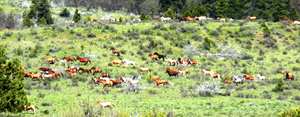The deer and elk populations on the reservation have improved in recent years, as the range habitat, especially winter range, has improved. This is a direct result of the Natural Resources Range and Ag horse removal program.
Range and Ag began horse removal in 2001, when there were almost 7,000 horses on the reservation. There are now about 3,500, approaching a manageable number, said Jason Smith, Range and Ag director.
Mr. Smith and Natural Resources general manager Bobby Brunoe reported last week to Tribal Council on horse removal. This will be the last year of the official program, though there will be an ongoing effort to keep the horse population under control, Smith said.
Range and Ag will work with the reservation grazing groups to maintain control of the horse numbers, he said.
Since 2011, Range and Ag has removed an average of more than 1,000 horses per year, for a total of about 7,300 removals. This not only brought the herd numbers down, but also prevented an escalation in the horse population.
Wild herds can increase in population from 10 to 25 percent, depending on conditions. Without the horse removal program, 2017 would have seen a reservation horse population of 15,000, increasing to more than 21,000 by 2020, according to projections.
This would have consumed and otherwise destroyed winter-range habitat for deer and elk.
“Since the horse removal program began the Wildlife Department has seen the vegetation improve in areas where there has been substantial horse removal, especially in the Mutton Mountains,” said Andrea Karoglanian, tribal wildlife biologist.
“The horse removal program is very beneficial to the Warm Springs deer and elk populations, and is one essential part needed to improve wildlife populations on the reservation.”
Fish habitat and native plants also benefit from reduced horse numbers, as the animals forage through riparian areas, said Brad Houslet, tribal fisheries biologist.
Other benefits of the program have been employment and income opportunities for mermbres, job skills building, and recognition by youth of the tribal horse culture, Jayson Smith said.
The horse removal program is funded through the settlement money the tribes received in a natural resources lawsuit against the federal government. The money was ear-marked for horse population control.
In 2006 the federal government stopped funding for horsemeat inspection. The effect was the closure of the few processing facilities in the U.S., leaving Canada and Mexico as the available markets.
At the Council update last week, Wasco Chief J.R. Smith Sr. asked what would happen if these markets were blocked.
The result could be devastation to the range habitat, as there would be no option for controlling the horse population, Bobby Brunoe said. “We do think about that, and it would be devastating,” he said.
Meanwhile, there may be a chance at the federal level to re-open a domestic market, Mr. Smith. He is a member of the National Tribal Horse Coalition, and follows developments in the industry.


